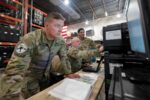In a significant step toward next-generation air combat capability, BAE Systems and QinetiQ have successfully demonstrated manned-unmanned teaming (MUM-T) involving the Eurofighter Typhoon and multiple unmanned aerial vehicles (UAVs). The trials mark a key milestone in the UK’s efforts to develop advanced human-machine integration as part of its Future Combat Air System (FCAS) roadmap.
Live MUM-T Trials Over UK Airspace
The demonstration took place in September 2025 over UK-controlled airspace using a modified Eurofighter Typhoon acting as a command platform. During the test flights, the Typhoon pilot was able to task and control multiple UAVs in real time using secure datalinks. The UAVs—supplied by QinetiQ—executed coordinated ISR (intelligence, surveillance, reconnaissance) missions while relaying sensor data back to the manned aircraft.
This trial builds on earlier synthetic environment simulations conducted under Project Alvina—a UK Ministry of Defence initiative focused on developing MUM-T capabilities. According to BAE Systems and QinetiQ statements, this was the first time such teaming was demonstrated live in British airspace using operationally relevant platforms.
Technical Architecture and Control Interface
The demonstration leveraged a digital mission management system developed by BAE Systems that enabled seamless tasking of unmanned assets from the cockpit. This included assigning surveillance zones, redirecting flight paths mid-mission, and receiving real-time electro-optical/infrared (EO/IR) feeds from onboard UAV sensors.
Secure communications were facilitated via Line-of-Sight (LOS) datalinks integrated into both manned and unmanned platforms. While specifics on bandwidth or waveform types remain undisclosed due to operational security concerns, industry sources suggest that Link-16 or proprietary encrypted protocols were likely used for command-and-control functions.
The trial also tested levels of autonomy in UAV behavior. While human-in-the-loop control remained central for mission-critical decisions, the drones demonstrated semi-autonomous navigation and sensor cueing based on pre-programmed mission profiles.
Strategic Context: FCAS and Tempest Integration
The successful MUM-T trial aligns with broader UK defense goals under its Future Combat Air System program. The FCAS initiative—anchored by the sixth-generation Tempest fighter—is designed around modularity and interoperability between crewed aircraft and autonomous systems.
MUM-T is expected to be a foundational capability within Tempest’s operational concept. Lessons learned from these Typhoon-based trials will directly inform software architectures, AI decision support tools, sensor fusion algorithms, and secure networking protocols for FCAS development.
Moreover, this effort reflects NATO-aligned trends toward distributed lethality—where swarming UAVs can extend sensor range or deliver kinetic effects while minimizing risk to pilots. Comparable programs include the U.S. Air Force’s Skyborg Vanguard project and Australia’s Loyal Wingman initiative developed by Boeing Defence Australia.
Industry Collaboration Between BAE Systems and QinetiQ
This demonstration underscores growing collaboration between major UK defense primes in advancing autonomous combat technologies. BAE Systems led integration efforts on the Typhoon platform while QinetiQ provided its expertise in drone design and autonomous flight systems through its experimentation fleet of jet-powered testbed UAVs.
- BAE Systems: Responsible for cockpit interface design, mission management software integration into Typhoon avionics suite
- QinetiQ: Supplied experimental drones equipped with ISR payloads; managed ground control stations; supported safety case development
- UK MOD: Provided regulatory oversight via Defence Equipment & Support (DE&S); ensured compliance with Civil Aviation Authority rules for mixed-traffic airspace operations
The companies emphasized that this is part of an iterative test campaign aimed at maturing human-machine teaming concepts through spiraled development cycles rather than one-off demonstrations.
Operational Implications for RAF Force Structure
If fielded at scale within frontline squadrons by 2030–2035 timelines envisioned under FCAS planning assumptions, MUM-T could transform Royal Air Force doctrine across several mission sets:
- Aerial ISR: Drones can scout ahead or loiter over contested zones without risking crewed platforms
- Saturation attacks: Swarms can overwhelm enemy IADS before manned fighters enter engagement range
- Cognitive offloading: AI-enabled drones can handle routine tasks or data triage during complex missions
- BDA & strike coordination: Uncrewed assets can provide real-time bomb damage assessment or designate targets post-strike
This capability also supports distributed operations—allowing fewer high-value aircraft like Typhoons or future Tempests to command larger formations of low-cost attritable systems across dispersed theaters such as Eastern Europe or Indo-Pacific littorals.
MUM-T Challenges Ahead: Autonomy Trust & C4ISR Interoperability
Despite promising results from this trial phase, several technical hurdles remain before full operational deployment is feasible:
- Cognitive load management: Ensuring pilots are not overwhelmed when managing multiple uncrewed assets during dynamic engagements remains a major UI/UX challenge.
- Spectrum deconfliction: Operating swarms requires robust electromagnetic spectrum management to avoid jamming or signal loss—especially against peer EW threats like Russia or China.
- NATO interoperability: Future deployments will require harmonization of datalink standards such as Link-16/22 or STANAG-compliant interfaces across coalition partners’ platforms.
- Sovereign AI assurance: Ensuring algorithmic transparency and ethical frameworks around lethal autonomy remain key policy issues under review by MOD’s Defence AI Centre (DAIC).
The UK’s approach appears focused on gradual capability insertion—first enabling limited teaming roles such as ISR cueing before progressing toward more autonomous strike coordination missions in later spiral upgrades post-2030.
A Glimpse into Sixth-Generation Warfare Concepts
This trial provides tangible evidence that sixth-generation warfare concepts are moving out of PowerPoint slides into real-world testing environments. As legacy fourth-gen fighters like Typhoon are retrofitted with digital backbones capable of commanding drones in-flight, they serve as valuable testbeds bridging current force structures with future ones centered around human-machine collaboration at scale.
The integration path from these early demonstrations to full-spectrum multi-domain operations remains complex but increasingly achievable given sustained investment by UK MOD alongside industrial innovation from firms like BAE Systems and QinetiQ. The coming years will determine how quickly these capabilities transition from experimental sorties into deployable force multipliers shaping tomorrow’s battlespace dynamics.








